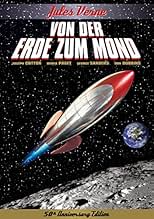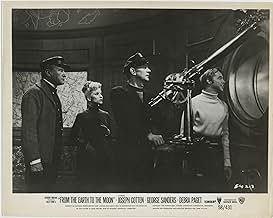ÉVALUATION IMDb
5,1/10
1,9 k
MA NOTE
Ajouter une intrigue dans votre langueIn 1868, American inventor Victor Barbicane develops a powerful military explosive that he also uses as fuel for a moon-bound rocket manned by himself and a motley crew.In 1868, American inventor Victor Barbicane develops a powerful military explosive that he also uses as fuel for a moon-bound rocket manned by himself and a motley crew.In 1868, American inventor Victor Barbicane develops a powerful military explosive that he also uses as fuel for a moon-bound rocket manned by himself and a motley crew.
Ludwig Stössel
- Aldo Von Metz
- (as Ludwig Stossel)
Morris Ankrum
- US President
- (uncredited)
Robert Clarke
- Narrator
- (voice)
- (uncredited)
Les Tremayne
- Countdown Announcer
- (uncredited)
Histoire
Le saviez-vous
- AnecdotesSome of the music is actually the "electronic tonalities" created by Louis Barron and Bebe Barron for Planète interdite (1956).
- GaffesDespite dire warnings of death should occupants of the projectile NOT be in the "acceleration tubes" upon launch, no explanation is offered as to why Virginia isn't turned to goo by stowing away in another room.
- Générique farfeluOpening credits are on the pages of a book, with the leads' photos included above the name.
- ConnexionsReferenced in Trumbo (2007)
- Bandes originalesElectronic Tonalities
(uncredited)
from Planète interdite (1956)
composed by Bebe Barron and Louis Barron
heard during the scenes on board the rocket
Commentaire en vedette
After TWENTY THOUSAND LEAGUES UNDER THE SEA and AROUND THE WORLD IN EIGHTY DAYS it is most likely that the most popular of Jules Verne's titles (the ones that most people are familiar with) is his 1865 novel FROM THE EARTH TO THE MOON, together with it's first sequel, the 1870 novel AROUND THE MOON. What fascinates everyone is that for all the errors we now know of Verne's huge cannon idea (it would crush and vaporize the space travelers before they left the cannon's mouth) he was on target on so many points. He felt the Americans would do it first (we did - though barely); It would be sent from Florida (near where Cape Kennedy is located, by the way); Texas would be important in the project (in the novel Texas wants the honor of being the site of the cannon, but in reality Nasa's central space tracking center is in Houston); The capsule would be bullet shaped (not quite correct, but look at the rockets we used); The capsule would return to the earth and land in the Atlantic, to be recovered by an American battleship. Nice guesswork (or homework) Jules! To be fair to Verne, even his cannon idea was not a bad one - it was more plausible than Cyrano de Bergerac's bottles of morning dew (which his poetic fancy said would lift the traveler) or Poe's free flying balloon in HANS PFALL. But what is not noticed by most readers (due to translations) is Verne's social and political satire. He liked Americans, but he recognized our bellicosity, self-image building (we always did it better than anyone else) and our economic and political expansionism. Verne, like many Frenchmen, supported Lincoln and the North in the Civil War, especially after the Emancipation Proclamation. In 1887 he wrote a two volume novel NORTH AND SOUTH, in which the Confederates are the villains. But he saw American enterprise as haphazard and not well planned. He was very critical of it in THE FLOATING ISLAND, where greed by American millionaires destroys a remarkable artificial island. Even in his first published novel, FIVE WEEKS IN A BALLOON, at a philosophical moment one of the characters says that if the world ever is destroyed an American will have a hand in it.
So in the novel, the Baltimore Gun Club members are all leading engineers who helped the Northern cause by building better guns and cannon. Most of them are missing limbs as a result. The President of the club, J.P. Barbicane (in some versions his name is "Impey" Barbicane) has his limbs. His closest associate, the club's secretary, J.T. Maston, has most of his body, but has one hook for a hand. They are the only members with "in tact" bodies. The club is seeking something to do with it's time, after the Confederacy collapses. Barbicane suggests building the "Columbiad" (which, by the way, is the cannon, not the projectile) to travel or communicate with the moon. The plan is barely presented when Maston suggests using the cannon instead to annex Mexico! See - Verne has our bellicosity down quite pat.
Barbicane has a wartime rival, one Captain Nicholl. Nicholl specialized in better and better armor. Barbicane specialized in better and better shells to pierce the armor. Nicholl will soon become the leading critic of the scheme.
Verne (in real life) was a friend of the prominent aeronaut and photographer, Nadar. Nadar became the model for the French adventurer Michel Ardan (note the anagram last name for "Nadar") who proposes traveling in the projectile to the moon. Barbicane and Nicholl end up joining him (while Maston will be in charge of carefully following their travel by powerful telescope). The flight actually had great accuracy in detailing the length of the trip (four days) and in showing the amazing effect of weightlessness (Verne noted that by leaving the gravity field of earth this would result). The capsule never lands on the moon (it couldn't, because if it had it would not have been capable of getting back. Verne explains that there is a miscalculation in the calculations of the trajectory. This enables the moon to help send the capsule back to earth.
Nadar/Ardan is not in the movie. Nicholl does not become so completely involved and willing to work with Barbicane as the novel shows. George Sanders' Stuyvesant Nicholl ("Stuyvesant"?) remains hostile to Joseph Cotton's Victor Barbicane (what happened to "Impey") up to a few minutes before the conclusion. There is no power X in the novel - no new energy source. The movie was made in the 1950s, so the public had to think that Verne was thinking in terms of atomic power. Actually he never did. There is no romance between the children of Sanders and Cotton. These changes in the film help weaken the film in comparison to the novel (which still reads well - try to get the translation by Walter Miller that is the best in English).
This was not the only film version of the novel. The classic early film by George Melies, A TRIP TO THE MOON, has a period charm that makes one forget it's cardboard backgrounds (and it's projectile in the eye of the man in the moon is a classic moment of cinema). And then there was the film ROCKET TO THE MOON which turned the story into an all-star comedy with Burl Ives, Terry-Thomas, Lionel Jeffries, and Dennis Price.
Verne was not finished with his travelers either, after AROUND THE MOON. In 1889 he wrote THE PURCHASE OF THE NORTH POLE, where the Gun Club decides to use the Columbiad to alter the tilt of the globe. Ardan does not reappear, but Barbicane, Nicholl, and Marston do. It is not as good a novel as the first two.
So in the novel, the Baltimore Gun Club members are all leading engineers who helped the Northern cause by building better guns and cannon. Most of them are missing limbs as a result. The President of the club, J.P. Barbicane (in some versions his name is "Impey" Barbicane) has his limbs. His closest associate, the club's secretary, J.T. Maston, has most of his body, but has one hook for a hand. They are the only members with "in tact" bodies. The club is seeking something to do with it's time, after the Confederacy collapses. Barbicane suggests building the "Columbiad" (which, by the way, is the cannon, not the projectile) to travel or communicate with the moon. The plan is barely presented when Maston suggests using the cannon instead to annex Mexico! See - Verne has our bellicosity down quite pat.
Barbicane has a wartime rival, one Captain Nicholl. Nicholl specialized in better and better armor. Barbicane specialized in better and better shells to pierce the armor. Nicholl will soon become the leading critic of the scheme.
Verne (in real life) was a friend of the prominent aeronaut and photographer, Nadar. Nadar became the model for the French adventurer Michel Ardan (note the anagram last name for "Nadar") who proposes traveling in the projectile to the moon. Barbicane and Nicholl end up joining him (while Maston will be in charge of carefully following their travel by powerful telescope). The flight actually had great accuracy in detailing the length of the trip (four days) and in showing the amazing effect of weightlessness (Verne noted that by leaving the gravity field of earth this would result). The capsule never lands on the moon (it couldn't, because if it had it would not have been capable of getting back. Verne explains that there is a miscalculation in the calculations of the trajectory. This enables the moon to help send the capsule back to earth.
Nadar/Ardan is not in the movie. Nicholl does not become so completely involved and willing to work with Barbicane as the novel shows. George Sanders' Stuyvesant Nicholl ("Stuyvesant"?) remains hostile to Joseph Cotton's Victor Barbicane (what happened to "Impey") up to a few minutes before the conclusion. There is no power X in the novel - no new energy source. The movie was made in the 1950s, so the public had to think that Verne was thinking in terms of atomic power. Actually he never did. There is no romance between the children of Sanders and Cotton. These changes in the film help weaken the film in comparison to the novel (which still reads well - try to get the translation by Walter Miller that is the best in English).
This was not the only film version of the novel. The classic early film by George Melies, A TRIP TO THE MOON, has a period charm that makes one forget it's cardboard backgrounds (and it's projectile in the eye of the man in the moon is a classic moment of cinema). And then there was the film ROCKET TO THE MOON which turned the story into an all-star comedy with Burl Ives, Terry-Thomas, Lionel Jeffries, and Dennis Price.
Verne was not finished with his travelers either, after AROUND THE MOON. In 1889 he wrote THE PURCHASE OF THE NORTH POLE, where the Gun Club decides to use the Columbiad to alter the tilt of the globe. Ardan does not reappear, but Barbicane, Nicholl, and Marston do. It is not as good a novel as the first two.
- theowinthrop
- 18 sept. 2005
- Lien permanent
Meilleurs choix
Connectez-vous pour évaluer et surveiller les recommandations personnalisées
- How long is From the Earth to the Moon?Propulsé par Alexa
Détails
- Date de sortie
- Pays d’origine
- Langue
- Aussi connu sous le nom de
- Von der Erde zum Mond
- Lieux de tournage
- sociétés de production
- Consultez plus de crédits d'entreprise sur IMDbPro
- Durée1 heure 41 minutes
- Rapport de forme
- 1.85 : 1
Contribuer à cette page
Suggérer une modification ou ajouter du contenu manquant

Lacune principale
By what name was From the Earth to the Moon (1958) officially released in India in English?
Répondre

































